Original Emigration to Hahndorf
Hahndorf was settled by persecuted Lutherans fleeing for their faith from Prussian and East Germany in 1839. Through their hard work, these people made a significant contribution to the progress of the new colony of South Australia which had become a British province in 1836 and later joined the Commonwealth of Australia in 1901. It was the first Australian town specifically planned for and settled by a group of non- British immigrants. Hahndorf is Australia's oldest surviving Germanic settlement.
Reasons for Emigration
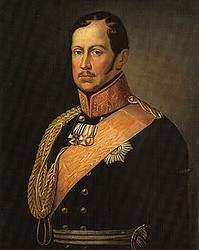 King Frederich Wilhelm IIIOn 27th September 1817, King Frederich Wilhelm III of Prussia declared that the Lutheran and Reformed Calvanist churches should amalgamate and become one church under the Government. In 1821, he attempted to force his 'Order of Service' on all congregations. Many Lutherans denied the State any right to dictate to them in matters of religion. After many years of persecution for their refusal to comply with the wishes of the King, many decided to leave. They came mainly from the eastern provinces of Prussia.
King Frederich Wilhelm IIIOn 27th September 1817, King Frederich Wilhelm III of Prussia declared that the Lutheran and Reformed Calvanist churches should amalgamate and become one church under the Government. In 1821, he attempted to force his 'Order of Service' on all congregations. Many Lutherans denied the State any right to dictate to them in matters of religion. After many years of persecution for their refusal to comply with the wishes of the King, many decided to leave. They came mainly from the eastern provinces of Prussia.
Further extensive details of the above is available from the Wikipedia site Prussian Union (Evangelical Christian Church).
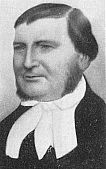 Pastor Kavell Pastor August Ludwig Christian Kavel, a deposed Lutheran Minister, was one of the principal figures regarding Lutheran emigration to South Australia. To avoid imprisonment for conducting religious services in Prussia, he escaped to England. While working on the wharves he met George Fife Angas who was one of the founding fathers of the new British colony of South Australia. Angas was in need of labourers for developmental work in the only Australian colony established without convict labour. This had taken place in 1836. The two men struck a deal. In return for financing the emigration from Prussia and settlement of Kavel's parishioners in the new colony, Angas would be assured of a skilled, diligent workforce and be repaid with interest.
Pastor Kavell Pastor August Ludwig Christian Kavel, a deposed Lutheran Minister, was one of the principal figures regarding Lutheran emigration to South Australia. To avoid imprisonment for conducting religious services in Prussia, he escaped to England. While working on the wharves he met George Fife Angas who was one of the founding fathers of the new British colony of South Australia. Angas was in need of labourers for developmental work in the only Australian colony established without convict labour. This had taken place in 1836. The two men struck a deal. In return for financing the emigration from Prussia and settlement of Kavel's parishioners in the new colony, Angas would be assured of a skilled, diligent workforce and be repaid with interest.
Journey by Sea
Four small ships brought the first group of Lutheran settlers to South Australia. 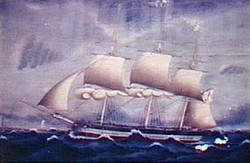 Painting of 'Zebra' After a previous unsuccessful attempt by Pastor Kavell, on the 8th July 1838 he helped 250 Lutherans leave Hamburg, Germany to set sail on the 'Prince George' and 'Bengalee' (financed by George Fife Angas) , eventually landing in the colony on 20th November 1838. They settled first in Port Adelaide, then on 144 acres of land belonging to George Fife Angas on the banks of the River Torrens. The settlement was named Klemzig and was the first village settled by Lutherans.
Painting of 'Zebra' After a previous unsuccessful attempt by Pastor Kavell, on the 8th July 1838 he helped 250 Lutherans leave Hamburg, Germany to set sail on the 'Prince George' and 'Bengalee' (financed by George Fife Angas) , eventually landing in the colony on 20th November 1838. They settled first in Port Adelaide, then on 144 acres of land belonging to George Fife Angas on the banks of the River Torrens. The settlement was named Klemzig and was the first village settled by Lutherans.
On 8 June 1838, another group had embarked on river barges at Tschicherzig and then travelled down the Oder, along connecting canels, and down the Elbe to Hamburg. They then waited at Hamburg for 6 weeks before going to nearby Altona and boarding the Danish ship 'Zebra' under the command of Captain Dirk Hahn. A Mrs Richardson financed their voyage which began on the 12th August 1838, two years to the day after the official proclamation of the state of South Australia.
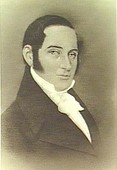 Capt Hann (c1836)The 'Zebra' was a 3 masted ship of 350 tons built in 1818. Apart from the passengers, the 'Zebra' carried 100 barrels of pork, 100 barrels of flower, 65 barrels of fresh water, 17 hogheads of beer and vinegar, 14 barrels of herrings, 2 boxes of boots and shoes, and 40,924 bricks.
Capt Hann (c1836)The 'Zebra' was a 3 masted ship of 350 tons built in 1818. Apart from the passengers, the 'Zebra' carried 100 barrels of pork, 100 barrels of flower, 65 barrels of fresh water, 17 hogheads of beer and vinegar, 14 barrels of herrings, 2 boxes of boots and shoes, and 40,924 bricks.
Even before the 'Zebra' left the wharf two children had died. Eight days later two more had died and several more were ailing. Dr Mathieson, who had been appointed to keep order and to distribute provisions, tried in vain to persuade the captain to put into harbour to allow the sick to recover. This scheme was considered impractical. By 24 September the eighth corpse had been buried at sea.
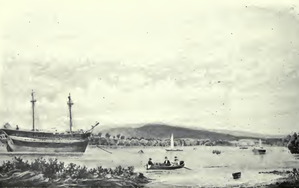 Port Adelaide 1838 Stringent measures were introduced for restoration of health. All healthy passengers took turns in spending a day and a night on deck so the sick could have more room and air. Sails to catch the wind were let down in all hatchways. The beds were brought out on deck and aired while the sleeping quarters were fumigated with vinegar and juniper berry three times a day. Sufferers of scurvy recovered after a diet of sauerkraut and raw potatoes coupled with compulsory daily exercise. Recurring bouts of chickenpox and typhoid ceased as the ship crossed the equator.
Port Adelaide 1838 Stringent measures were introduced for restoration of health. All healthy passengers took turns in spending a day and a night on deck so the sick could have more room and air. Sails to catch the wind were let down in all hatchways. The beds were brought out on deck and aired while the sleeping quarters were fumigated with vinegar and juniper berry three times a day. Sufferers of scurvy recovered after a diet of sauerkraut and raw potatoes coupled with compulsory daily exercise. Recurring bouts of chickenpox and typhoid ceased as the ship crossed the equator.
After leaving Altona, the 'Zebra' reached Holdfast Bay (Adelaide) on Friday, 28 December 1838 and Port Adelaide, known as Port Misery, four days later on Wednesday, 2 January 1839. The 'Zebra' started with 106 adults and 91 children as passengers. Six adults and five children died on the voyage. The 'Zebra' was the first ship to fly a foreign flag in the port, and as a result attracted considerable interest. A further ship, the 'Catherina' arrived in January 1839.
Arrival
The new arrivals were united with Pastor Kavel, who suggested they settle on a second parcel of land in Klemzig, next to the first 250 Lutherans who had arrived shortly before them, but they were looking for more suitable land of their own to settle and farm.
 Village of KlemzigWhile his passengers camped in the sandhills, the ship's captain, Dirk Meinertz Hahn, set off to find suitable land where they could settle as a religious farming community. Although they were fine people, they were simple peasants who were not experienced in business matters. Captain Hahn, who thought highly of his passengers and was impressed by their strong beliefs and courage on a long and at times difficult voyage, was prompted to help them to find suitable land. He had been touched by their plight. Many were impoverished due to years of penalties paid to the King who also confiscated property belonging to people known to be practicing Lutherans. They were also in debt to Mrs Richardson. But, they had skills required by the new colony and they were willing to work very hard to improve their circumstances.
Village of KlemzigWhile his passengers camped in the sandhills, the ship's captain, Dirk Meinertz Hahn, set off to find suitable land where they could settle as a religious farming community. Although they were fine people, they were simple peasants who were not experienced in business matters. Captain Hahn, who thought highly of his passengers and was impressed by their strong beliefs and courage on a long and at times difficult voyage, was prompted to help them to find suitable land. He had been touched by their plight. Many were impoverished due to years of penalties paid to the King who also confiscated property belonging to people known to be practicing Lutherans. They were also in debt to Mrs Richardson. But, they had skills required by the new colony and they were willing to work very hard to improve their circumstances.
After investigating a number of sites and proposals which were considered to be unsuitable, Captain Hahn received a written invitation from William Hampden Dutton and his partners, Captain John Finnis and Duncan Macfarlane to join them in an excursion to view the land they had just acquired near Mount Barker. William Hampden Dutton and his partners had just purchased the 'First Special Survey' of 4000 acres in the Mount Lofty Ranges of South Australia and were planning to develop a township at the foot of Mount Barker. On 24th January 1839, a party of 18 plus servants and including Captain Hahn, set out to investigate the land in question. They breakfasted on the top of Mount Lofty, lunched under a large gum tree surrounded by virgin bush, and then continued their journey until the country opened out into a fine green meadow with the Onkaparinga River nearby.
Agreement
Captain Hahn was so impressed with the site that he immediately asked that the Lutheran immigrants be allowed to settle there. He was then requested to draft an Agreement which he then submitted to the owners, William Hampton Dutton, Captain John Finnis and Duncan Macfarlane.
This consisted of the following four requests:
- ''One hundred acres of land are to be set aside for them, rent-free during the first year. Of this area, nineteen acres are to be set aside for the erection of houses and the construction of roads; the remainder is to be used for cultivation, divided amongst the 38 families;''
- ''The above-mentioned gentlemen partners pledge themselves to deliver the emigrants and their belongings to the dwelling place granted them - this to be on credit;''
- ''The above-mentioned gentlemen pledge themselves to provide the emigrants with provisions for one year, until they by indefatigable industry will harvest produce from the soil allotted to them. Seed of the kind they need is also to be provided, but this is to be debited to those who ask for seed and other provisions; it is not to be considered as a communal debt;''
- ''The partners promise to supply fowls, cattle and pigs on credit, in the expectation the the immigrants will soon be able to cancel their indebtness by selling their produce in town and be enabled to purchase their own domestic animals.''
The partners not only agreed to the above, but of their own account added that they would supply 6 milch cows to the group on arrival and if the new settlers proved themselves industrious and thorough workers, they would assist them with the building of a church and school in the following year. They promised to assist finacially with the support of a clegyman and schoolmaster and asked that Mr H Kook (Koch) should be appointed as supervisor of the new settlement. These agreements were to be valid for a year, on trial. If the land proved itself suitable for cultivation and if the settlers made a success of the undertaking through their industry, they would be granted more land at an appropriate rental and the partners would be prepared to engage more German immigrants of good character.
On 28 January 1839, Messrs Dutton, Finnis and MacFarlane came to the ship at Port Adelaide and concluded the agreement with the immigrants, granting them a lease of 150 acres instead of 100 and asking that each settler was to provide his own agricultural implements.
Hahndorf
A number of families from Klemzig and a few passengers from the 'Catherina' which had arrived on 22 January 1839, also expressed interest in moving to the new German village in the Adelaide Hills. To accommodate the extra families, three eighty acre sections of the first Special Survey (numbers 4002, 4003 and 4004), were eventually allotted to the Lutheran immigrants.
At Glen Osmond, a third Lutheran village became a temporary resting-place on the long trek up Mount Lofty to Hahndorf. Within a few years the rough huts erected by 'Catherina' passengers were abandoned as the immigrants moved further afield in search of more land. At Klemzig, most signs of its early European beginnings had disappeared by 1880 to make way for suburban development.
Hahndorf thus became and still is, the oldest surviving German settlement in Australia.
The Lutheran immigrants spent February 1839 walking from Port Adelaide carrying their belongings on their backs or in primitive handcarts to their new home in the hills. Some families left Klemzig to join them in the more fertile Onkaparinga River valley. When the first group reached the site on the 3rd March at the section of land allotted to them for a settlement, they stopped at a native 'bukartilla' or swimming hole, a little north of the present Post Office, and without waiting to unload, fell on their knees to give thanks to God for bringing them safely to this land of religious freedom. Then came the task of erecting huts and shelters. Later trees were felled and log-huts or pug-houses built. The ground was worked and an attempt was made to grow vegetables.
The 'Southern Australian', dated 30 January 1839, contained the following news item: ''Mr Dutton has made an offer to a number of Germans to get them on his section at Mount Barker. This village thus formed will be named 'Hahndorf', in compliment to Captain Hahn, of the Danish ship 'Zebra'.' ''
So in great appreciation for Captain Hahn's help, the new arrivals named their new home Hahndorf - ('Hahn's Village').
This land was divided up between the Founding Families of Hahndorf. Of these, 35 families were from the 'Zebra', 17 families were from the 'Prince George' and the 'Bengalee' who had arrived earlier with Pastor Kavel, and 2 families subsequently from the 'Catharina'. The land was broken up into smaller home size blocks, with larger blocks on the outskirts of the town for farming.
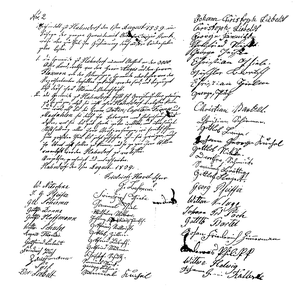 Document of Signatures - 1 August 1839 On 1 August 1839, fifty of these families signed a document stating that the community would take a share in the 3000 acres purchased in the Barosa district by the Klemzig congregation, but they were not prepared to leave Hahndorf unless they were compelled to do so by the failure of Messrs. Dutton, Finnis and MacFarlane to give the promised support until harvest or to fulfil the conditions of the agreement. They did not wish to become unfaithful to the promise they had given (Hahndorf and its Academy by Dr FJH Blaess)
Document of Signatures - 1 August 1839 On 1 August 1839, fifty of these families signed a document stating that the community would take a share in the 3000 acres purchased in the Barosa district by the Klemzig congregation, but they were not prepared to leave Hahndorf unless they were compelled to do so by the failure of Messrs. Dutton, Finnis and MacFarlane to give the promised support until harvest or to fulfil the conditions of the agreement. They did not wish to become unfaithful to the promise they had given (Hahndorf and its Academy by Dr FJH Blaess)
On 9 April 1840, the above families resolved to purchase the land, borrowing money at 10% interest to pay for it plus additional land to be purchased at a later date. Previously, they were unable to purchase the land as only British subjects were allowed to do so, however, this restriction had been removed.
The South Australian Register, dated Saturday 11 April 1840 stated: The Mount Barker Estate. — We observe that this fine property, with the exception of some town and suburban allotments, is withdrawn from the colonial market, and transferred to England for disposal under the direction of Captain Grey. Three 80-acre sections, however, were yesterday disposed of at Hahndorf, to the German settlers, at the rate of £7 per acre.
In a letter dated 17 November 1841, Mr Hermann Koch stated:
...... In addition, the Germans, besides the sections already named, have two other sections in the vicinity, bought from the Government at the original price, and several acres purchased from individuals. Thus they have six sections upon which 62 families reside.
Early German Emigration to South Australia
The arrival in SA of the earliest large numbers of refugee German Lutherans in four ships towards the end of 1838 is well-known. These people formed the first permanent German settlements in the state - Hahndorf and Klemzig. However, these were not the first German colonists to come to SA.
Through political and trade links with the various German states, South Australia’s main colonising body, the SA Company, had been hiring German labourers and professional people to go with the main groups of British colonists setting off for the new colony from February 1836. Indeed, the recruitment of Germans had progressed so well, that the Company selected a German confidential secretary for its colonial headquarters, to go out on the first emigrant vessel - the Duke of York.
This person was Daniel Schreyvogel, who worked first in Kingscote and then in Adelaide for Samuel Stephens and David McLaren, the first SA Company local Managers. Mr Schreyvogel acted as interpreter between the Germans and the British officials, and conducted the necessary record keeping involving the SA Company’s German employees.
Over a dozen single German men arrived in SA during late 1836 and early 1837 ‘to work the quarries of stone and lime and procure additional supplies of water from artesian wells’. This group also included Johann Menge, the eccentric mineralogist, who made SAs first discoveries of mineral wealth and pointed out the state’s suitability for winemaking. In October 1837, the ship Solway anchored in Nepean Bay, off Kangaroo Island. On board were 47 more Germans, amongst them seven married couples and their families. For FW Kleemann and his four children, the arrival was difficult indeed. After suffering poor health for most of the voyage, Mrs Kleemann died of pneumonia on 14 October 1837, several days before the ship berthed. Considerately, the captain agreed to keep her corpse on board and allow it burial on land in the new Kingscote cemetery. The grieving husband planted a mulberry tree near the spot (not in the cemetery as has so often been claimed), the first fruit tree planted in SA. This tree still survives.
Unfortunately, too many quarrels and other difficulties soon broke out between the SA Company officers and the Germans. Manager David McLaren informed headquarters in London that he absolutely refused to encourage any more Germans to settle in the young colony; this resolve was to cause unwelcome tension when the first considerable numbers of Germans who had no direct links with the SA Company arrived in late 1838.
Of the approximately sixty isolated Germans who came to SA in 1836-1837, most joined up with their countrymen in the newly-established German settlements near Adelaide, the Adelaide Hills and the Barossa Valley in due course. Several of these pioneer German colonists helped Colonel Light in the surveying of Adelaide and surrounding farm land. Most names have been forgotten, although in his time, FW Kleinschmidt became respected as a brewer and benefactor in Lobethal, in addition to the pioneering investigations (already mentioned) which Johann Menge carried out for the colony at large. Only Johann Gramp achieved presentday instant recognition with the establishment of Gramp’s winery at Rowlands Flat in the Barossa Valley.
Reg Butler - Hahndorf, 18 April 1995
Foot Notes:
1. KAVEL, August (1798-1862) - Born in Berlin and one of the earliest pupils in the new University there. A Kavel later became a Lutheran pastor in Klemzig, Brandenburg, south-east of the capital. Dissatisfied with a Protestant Church union which the Government forced upon the country, Kavel at last received permission for him and his congregation to emigrate to SA during 1838. He was the pioneer pastor in Klemzig and Hahndorf, and in the end settled at Tanunda, where he died. Fluent in English from working for several years in the London docks, Kavel often represented his people in dealings with the Government and private British settlers. - (Reg Butler)
2. ANGAS, George Fife (1789-1879) - Born in Newcastle-upon-Tyne, Northumberland, England, GF Angas worked in the family coachmaking industry there until his father’s death, the moving to London, where he took a great interest in banking and insurance. Later, Angas became one of the prime movers in the formation of the South Australian Company set up to promote the colonisation of the new province of South Australia. A Baptist by conviction, Angas sympathised with a group of persecuted Prussian Lutherans and lent them money to travel to South Australia in 1838. GF Angas and his wife moved to South Australia permanently in 1851, where he spent much time enlarging his business interests, belonging to the South Australian parliament and fostering various religious and charitable movements. - (Reg Butler)
3. ZEBRA, The - Built in 1818 for JN Dede, a merchant from Altona, in Schleswig-Holstein, Denmark. By the 1830s, ownership had passed to F Nicolaus Dede, a ship-building materials merchant, who engaged a fellow Dane, Dirk Hahn, to captain the vessel between 1836-1840. GF Angas chartered the boat in 1838 to take portion of the Prussian religious refugees he had sponsored to settle in SA. It was these people who founded Hahndorf in 1839 and named the settlement after Hahn, who had done so much to see that the emigrants had a safe journey and settled down as well as they could in their new land. - (Reg Butler)
4. PORT MISERY - The old Pt Adelaide, abandoned because the water was too shallow for ships to berth close to shore. Passengers had to go ashore by small boats (called lighters) through mangrove swamps. Such difficult conditions for loading and unloading vessels gave rise to the nickname Port Misery. - (Reg Butler)
5. KLEMZIG - Refugee Prussians established Klemzig SA in December 1838, on two sections of land belonging to GF Angas on the banks of the Torrens River upstream from Adelaide. The settlers and their spiritual leader, Pastor Kavel, named the place after their homeland village in Brandenburg. The spot soon became an important source of fresh vegetables for the people of Adelaide. - (Reg Butler)
6. FIRST SPECIAL SURVEY - GF Angas, Chairman of the South Australian Company, had insisted on the inclusion of Special Survey land sales in the South Australian land regulations issued in 1835. However, Governor Gawler was the first person to put this idea into action. He sold the First Special Survey to Messrs Dutton, Finnis and McFarlane on 11 January 1839. The partners paid £4,000 in advance for the survey of 15,000 acres in the vicinity of present-day Mount Barker; these men had the first choice of 4,000 acres and the rest was sold to the public at the uniform price of £1 an acre. Nearly forty Special Surveys were made until Governor Grey successfully urged the abolition of the scheme. - (Reg Butler)
7. DUTTON, William (1805-1849) - Born in Hanover, where his father held a diplomatic post, WH Dutton emigrated to Sydney and then Adelaide. He brought some stock overland and more by sea. In January 1839, W Dutton took out the colony’s first Special Survey with two partners. Too many business interests in Adelaide, Melbourne and Sydney to exercise efficient supervision led to WH Dutton’s bankruptcy in 1841. Eventually, William’s only surviving son, Henry, inherited Anlaby Station near Kapunda, established by William’s bachelor brother, Frederick. WH Dutton died in Melbourne, after which his widow, Charlotte, and her family returned to live in North Adelaide. Dutton’s mother-in-law had married his business partner John Finnis as her second husband. - (Reg Butler)
8. FINNIS, John (1802-1872) - Finnis first came to South Australia in 1838 with Captain Sturt, in charge of overlanding cattle. He established a station on the present site of Hahndorf for fattening beasts for market. Early the next year, Finnis joined with WH Dutton and L McFarlane in the purchase of the First Special Survey, which included the Hahndorf station. The first Hahndorf settlers worshipped in one of Finnis’s stockman’s huts. During the 1840s, he captained vessels trading passengers and goods between Britain and Australia and New Zealand; later, his ship took South Australian miners bound by sea to and from the Victorian gold diggings. - (Reg Butler)
9. MacFARLANE, Duncan (1793-1856) - Scottish-born MacFarlane arrived NSW 1824 as a sailor, and then began squatting in the mountains near present-day Canberra. Duncan came to SA 1838 with his friend, William Dutton, on the brig Parland. MacFarlane joined Dutton and Dutton’s father-in-law, John Finnis, in taking out the Mt Barker Special Survey during January 1839, the first such land sale in the colony. The men had brought with them substantial loans from a wealthy Sydney merchant, Thomas Walker, apparently to snap up property in such a fashion should it become available. MacFarlane established a station, using his own stock brought over by sea from NSW. Dependable Scottish shepherds came to live in a row of stone huts almost upon the later Mt Barker township, which Duncan and his partners laid out on part of MacFarlane’s sheep run during 1840. A sales office opened next to the homestead. Soon, scab and closer settlement made the area unsuitable for sheep and Duncan shifted his pastoral interests to the South-East. He also took up shares in the Glen Osmond silver-lead mines. In old age, D MacFarlane retired to his home at Glen Osmond. He was a JP and presided fairly over trials. - (Reg Butler)
|
Please note that information for this page and other related pages obtained mainly from: "HAHNDORF, A Journey Through the Village and its History" and "HAHNDORF: What's So Special?" by Anni Luur Fox, and "HAHNDORF AND ITS ACADEMY" by Dr F. J. H. Blaess, Historical information from Reg Butler (local historian), including: "HAHNDORF - Australia's Oldest Non-British Town", plus other Publications and sources. |
| Please Note: Further information regarding the History and Heritage of Hahndorf is available by 'clicking' on the ( Hahndorf ] and ( History & Heritage - Hahndorf ] tags below which will give a list of all pages similarly 'tagged'. |


